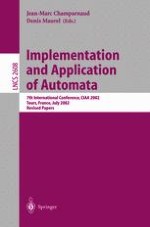2003 | Buch
Implementation and Application of Automata
7th International Conference, CIAA 2002 Tours, France, July 3–5, 2002 Revised Papers
herausgegeben von: Jean-Marc Champarnaud, Denis Maurel
Verlag: Springer Berlin Heidelberg
Buchreihe : Lecture Notes in Computer Science
Enthalten in: Professional Book Archive
